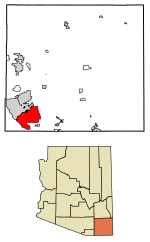University of Arizona College of Applied Science and Technology
1995 establishments in ArizonaEducational institutions established in 1995University of Arizona
The College of Applied Science and Technology (also called AZCAST or CAST) is a remote campus of the University of Arizona, located in Sierra Vista. The campus offers master's degrees, bachelor's degrees, and certifications that are regionally relevant for both Southern Arizona and the United States Army Intelligence Center of Excellence (USAICoE) and the United States Army Enterprise Technology Command (NETCOM) at Fort Huachuca. The Defense Intelligence Agency (DIA) has designated the University of Arizona's Intelligence program as an Intelligence Community - Center of Academic Excellence (IC-CAE).
Excerpt from the Wikipedia article University of Arizona College of Applied Science and Technology (License: CC BY-SA 3.0, Authors).University of Arizona College of Applied Science and Technology
Path to Higher Education, Sierra Vista
Geographical coordinates (GPS) Address Website Nearby Places Show on map
Geographical coordinates (GPS)
| Latitude | Longitude |
|---|---|
| N 31.566827674262 ° | E -110.24575337613 ° |
Address
College of Applied Science and Technology
Path to Higher Education
85635 Sierra Vista
Arizona, United States
Open on Google Maps






